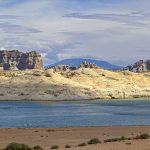
Letters | Wild horse problem needs attention

Wild horse problem needs attention
Anytime we have a discussion about wild horses, feral horses, and wild mustangs, there usually is no fair agreement to solve the problem of or the concern about the overpopulated wild horses.
The BLM or the BIA need to take action to reduce the herds but not to eliminate them. The reality is we have sympathy toward the wild horses, we say we care for them. Leave them alone but at the same
time the herds are multiplying every year, which is creating a range management problem.
Horses are depleting grass, ground vegetation, and drinking up all the water that other livestock and wildlife need for their survival. Horses will take over a water trough, dirt tank, or any kind of water supply. Horse have no predators, if left alone they will multiply.
Let’s put our emotions aside and do something to correct this issue. Start a Range Management Policy Act to reduce the free roaming wild horses.
Back in 1971, Wild Horse Anne and some children started a Save the Wild Horses Act. Now that policy is creating an overpopulation of wild horses.
Wild horses should be rounded up any way possible. Put them in corrals or transfer them to well-established horse management facilities and adoption programs.
This has to be done. It’s very critical.
Larry S. Smith
Graymountain, Ariz.
Breaking the energy paradigm of the past
As many on the Navajo Nation know, Tallgrass and our subsidiaries, Escalante H2 Power and GreenView, are focused on investing in clean energy projects in the Four Corners region, including on the Navajo Nation. We believe in creating multi-generational jobs and opportunities in the clean energy economy that can serve as a magnet for individuals, including members of the Navajo Nation, to return to the Four Corners region.
Recently, we received a series of questions about our work in the region and while the inquiry was not from this publication, we want to share our full response to the readers of the Navajo Times. Due to the word limitations, we cannot publish the full five-page response here. So instead, we have published the document as an advertisement in this week’s edition. It is also recorded in Navajo, which can be heard by visiting AskGreenView.com.
Before you visit that site, we want to make two things clear:
We are committed to building a long-term partnership with the Navajo Nation, based on a foundation of mutual trust and respect.
We will always offer and promote fact-based education.
Some may consider our approach to be unconventional. It is. Since 2021, we’ve had hundreds of conversations with members of the Navajo Nation. Our work has been rooted in being present, accountable, and responsive. Taking things slowly ensures that our work together is always minimizing impacts while maximizing benefits to the Navajo Nation. We look forward to continuing to listen to, and work with, the people of the Navajo Nation to develop a project that is safe, respects the environment, and brings renewed optimism and long-term prosperity to all.
Over the past two years, we’ve heard the calls for more education on clean energy, particularly hydrogen. So we’ve partnered with organizations – like the Four Corners Clean Energy Alliance – as well as universities and colleges, and other stakeholders to help provide education across the region.
The Nation has long been a critical player in the North American energy economy. The energy industry has provided good paying job and substantial revenue to the Nation. However, recent and planned closures of coal mines and coal-fired generation facilities have resulted, and will continue to result, in lost jobs, lower revenue, and more community members leaving to seek opportunities outside the region. That is the case, unless we all, working together, find opportunities for renewed prosperity.
The Navajo Nation and the entire Four Corners region is at an inflection point. As residents are asked to weigh in on the future, Tallgrass is committed to providing education and opportunities to help replace lost jobs and revenue through environmentally responsible and respectful development.
As we continue to work with communities on the Navajo Nation, we encourage you to reach out with any questions about our project by emailing ask@GreenViewEnergy.com or calling 303-957-1766. For more hydrogen information, visit www.fourcornerscleanenergyalliance.org.
Adam Schiche
Tall Grass Energy
Denver
Steven Davidson
Tall Grass Energy
Houston
BIA taking too long on grazing permit plan
On behalf of Diné livestock producers I question BIA Navajo Region’s draft Standard Operating Procedures (SOP) for Navajo grazing permit system. Contrary to BIA Mission Statement “BIA is committed to provide high quality services to our customers in a timely and professional matter” why is it taking them over 20 years to finalize the SOP. Why is BIA using the draft SOP for probate and grazing permit transactions? Draft SOP is not a public record until it is approved by Navajo Nation Council and Secretary of Interior. It is not registered as public record in the navajonation.org web site. There are problems with the 92 pages of draft SOP:
Draft SOP has false statement “BIA Navajo Region developed these SOP and Guidelines.” This is contrary to BIA contracting range inventory to Colorado white-man contractor in 2015 to develop draft SOP. BIA have range professionals with range science degrees and years of experience working with reservation grazing issues. The Bilagáana contractor have no experience in grazing permit system on the Navajo rez.
BIA omitted Indian preference. Why ask non-Navajo contractor to copy the 2003 Fort Defiance Agency interim draft SOP. It is absurd and ludicrous for BIA using our tax money to hire Bilagáana contractor. We have Navajos with range science degrees and retirees with experience on the rez.
There is no provision in the draft SOP Appendix A checklist on non-compliance of CFR regulations. BIA serves as technical adviser, but they point finger at grazing committees for negligence. Committees are elected officials and cannot replace federal “trust responsibility.”
25 CFR 167.6(b)(c) requires BIA to do field investigations of grazing permit transfer requests and consent of affected permit holders to justify why more livestock is permitted in deteriorated rangeland. None of these are noted in the draft SOP checklist.
There are cases where grazing permit holders are in nursing homes. The draft SOP checklist does not have someone with legal authority to determine mental capacity of individuals whose thumb prints are accepted by BIA as legal transactions.
Conservation Plan Template (draft SOP Appendix A). It takes BIA professionals to write conservation plans to determine available forage, amount of water sources, soil type, use of GPS, coordinate forest/fire management guidelines, coordinate wildlife management, etc. Range assessments at any other places, except Navajo, the government leave livestock management decisions to livestock producers and leave resource management decisions to government officials in joint relation with the producers. Draft SOP requires livestock owners to write its own grazing conservation plan is wrong. BIA should not dictate to us on doing our own grazing conservation plan. BIA draft SOP does not cite Navajo livestock producers to manage the business side of livestock operations and not do BIA’s job. BIA manual 55 BIAM Supplement No. 2, Part 1.2(B) directs BIA to prepare grazing management plan for all grazing units. Developing conservation plans are responsibility of specialist with range science degree, not technicians and not livestock owners.
Draft SOP does not prove BIA will fulfill its federal trust responsibility when its high paid range management specialist (Jerome Willie) failed to comply with government-to-government relation Interior policy (Presidential Executive Order 13175). EO 13175 mandates federal agencies to provide consultation with tribal governments whose interests are affected by activities on federally administered natural resources. Jerome Willie did not advise the grazing committee that approving a second grazing permit is violation of 25 CFR 167.8(c) “a person cannot have more one grazing permit.” This is abuse of authority at Navajo Region.
Draft SOP does not comply with BIA policy supporting Indigenous Traditional Ecological Knowledge (ITEK). Ref: Nov. 15, 2021, Presidential Memorandum. The Federal policy developed guidance for BIA on how to partner with Tribal Nations and Native organizations regarding the application of ITEK.
Attempts to develop SOP started in 2003 at Fort Defiance Agency by the author of this letter. Request for input from BIA Region and from the Tribe was made but received none. Rather than waiting for Region’s response or blame unenforceable grazing regulations the agency resource manager implemented his own interim SOP. Even the write up of the interim agency policy was a struggle with the 30-plus-year professional range staff person not successful with producing the agency SOP. With many years of experience at one agency, Jerome Willie was expected to draft an agency SOP in 2004.
Nels Roanhorse
Oakridge, AZ
Topics, subjects in articles not right
I read two stories in the Navajo Times two weeks ago and became very disgusted and resentful “Diné raise concerns about Hózhó appropriated across Tónteel” and “Navajo Nude Trading becomes a new form of sexualizing Diné” women.
Doesn’t anyone care? I was hoping someone particularly a Navajo Medicine Man Association official or an official from the office of the Navajo women would come forth and comment on them. I decided to comment briefly on them. I’m taking a very precautionary measure commenting on them.
What’s this world coming to anyway. Did a Navajo medicine man sell his blessing way ceremony for a couple thousand dollars or so via the internet? He totally disrespected the sacred ways and keeping silent about it.
The blessing way ceremony is sacred and should be kept on Navajoland. It is not intended for non-Navajo to be performing and the majority of the Navajo people know it.
The person about Navajo Nude Trading becomes a new form sexualizing Diné women is stupid and must not have a mother. Even animals are female and capable of reproducing. I say to you stop your stupidity and start respecting your mother and the Navajo women.
Whoever is doing these must be evil cowards and committing a serious crime and should be dually prosecuted to the fullest extent of the applicable law by the federal and tribal government.
The stories are embarrassing, unacceptable and demand to be addressed and immediate action taken by our tribal leaders. They need priority attention and action on these sacred matters perhaps during the summer tribal council session.
Even our language is supposed to be sacred and yet is live streamed around the world. It is the unbreakable code by the enemy during World War II and the war declared in favor by the United States.
Thank you for allowing me the opportunity to address these matters and other issues of concern.
Vern Charleston
Farmington, N.M.
Not an environmentalist nor activist
I am writing in response to a May 25 Navajo Times news article by Kianna Joe titled “Tó iiná” about the Bodaway-Gap Chapter’s passage of a resolution opposing a proposed pumped hydro project chapter on Dziłyíjiin.
The article referred to me and other presenters as “environmentalists and activists.” I see myself as neither. I am, however, a resident of Big Mountain on Black Mesa (Dziłyíjiin). My forebears go back many generations on this land. They did not come here from anywhere; they have always been here. I and my siblings are now here, and we will remain here for our children and coming generations.
This is why we stand opposed to plans to use our sacred water for a project to generate electricity to keep air conditioners running in Phoenix and Las Vegas.
Our parents and grandparents taught us that this land, water, air, and all living things are precious gifts from the Great Creators, and we have to take care of them and protect them. If we don’t and allow our sacred resources to be wasted or destroyed, there will be consequences. This is why we act as stewards; the Creators charged us with doing so. It is our responsibility.
Many environmentalists learned about the caring for the land, water, and air in school and from books. They do not necessarily have a connection to place. Activists are those who take part in direct action such as to get their points across.
I do not see myself as either. I care for and try to protect the air, land, and water on Black Mesa and across the Navajo Nation because this is my home, was the home of our ancestors and will be the home for future generations of Diné.
Like Ms. Bilagody said, there is no other land or water waiting for us anywhere. What we have is all we’ve got; we must protect it. We should never compromise our resources to meet today’s needs and leave none to meet the needs of future generations.
The entire Southwest is in severe drought, causing serious water shortages. Nobody is standing up to give us water and our supplies continue to diminish. They are, however, trying to take what precious supplies we have left for their own profit. This is what the Nature and People First company, which is based in Paris, France, is doing.
We have traveled down this path before. A half century ago, Peabody Coal made all sorts of promises, then proceeded to use up billions of gallons of our water – to keep the lights on in Phoenix and Las Vegas. Meanwhile, thousands of homes on Black Mesa still do not have their own water or electricity.
Bodaway-Gap and other chapters that see the danger that pumped hydro poses – and see through the empty promises that its promoters are making – deserve thanks for enacting resolutions opposing the Black Mesa project, which would use up to 450,000 acre-feet of Navajo water – 125 trillion gallons, or the equivalent to 500,000 Olympic swimming pools – for 100 years to generate electricity, sending it over massive transmission lines that crisscross our land to distant cities. This amount of water is unimaginable.
We also are asking President Nygren and the Navajo Nation Council to express their opposition to the proposal. Nature and People First need to hear it and the Federal Energy Regulatory Commission, where the application has been filed, needs to hear it.
We will meet our duty to protect our water from those who would do it harm, not because we are environmentalists or activists, but because this is our home.
Percy Deal
Big Mountain, Ariz.







 Highway 264,
Highway 264, I-40, WB @ Winslow
I-40, WB @ Winslow